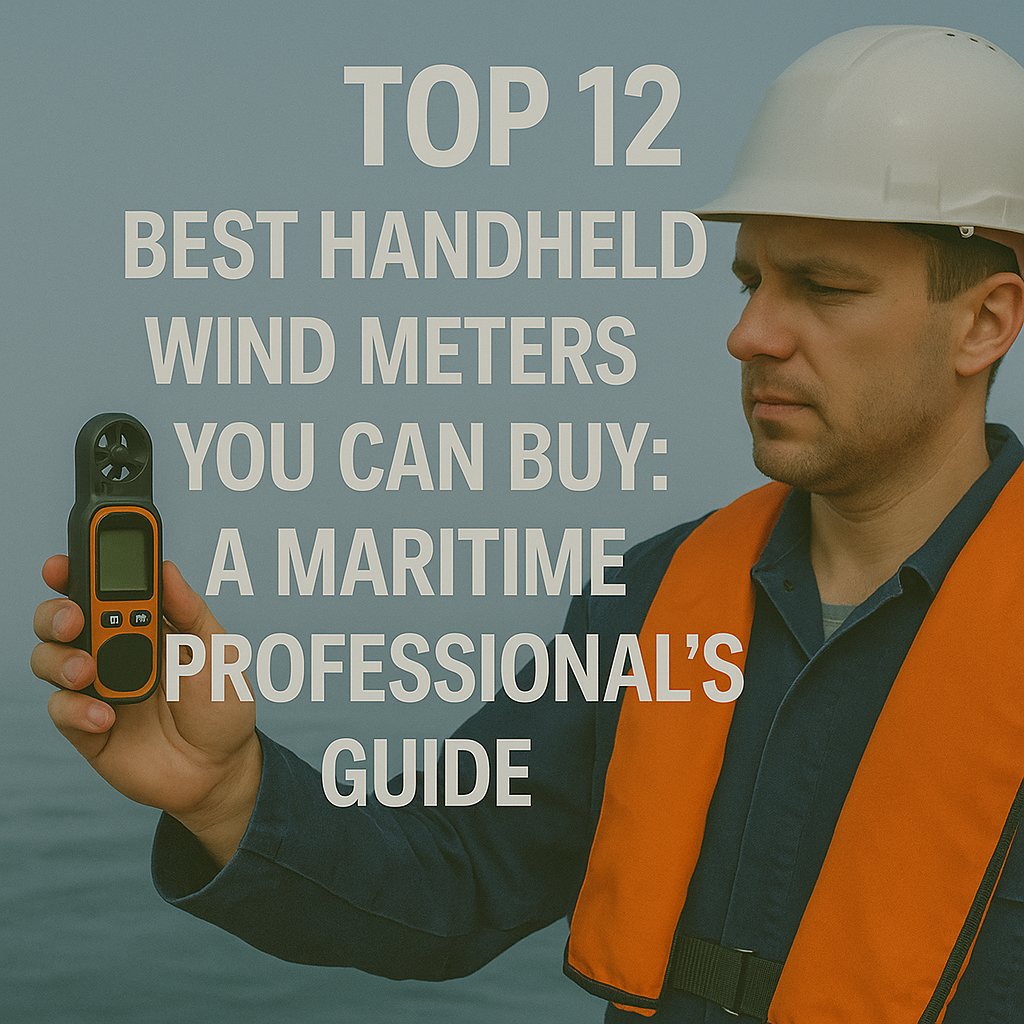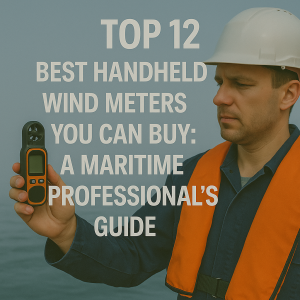Explore the top 12 handheld wind meters that every mariner, sailor, or outdoor enthusiast should consider. Measure wind speed, temperature, and more with these reliable, portable anemometers.
For centuries, the wind has ruled seafarers’ lives. From the era of tall ships to modern offshore operations, understanding wind conditions has meant the difference between safety and disaster. Today, technology has given us powerful tools to measure wind with a precision unimaginable in the age of square sails: handheld wind meters. Whether you are a deck officer, a port pilot, a sailing enthusiast, or even a rescue coordinator, knowing how to measure wind speed, direction, and temperature quickly is essential. Modern handheld anemometers pack advanced sensors into pocket-sized devices, providing crucial data in seconds.
Why Wind Meters Matter in Modern Maritime Operations
Wind might seem like a romantic force, but for the maritime world, it is a critical factor for safety and efficiency.
Wind affects ship maneuvering, tug operations, crane lifts, pilot transfers, and even cargo lashings. According to the International Maritime Organization (IMO, 2023), strong gusts have contributed to hundreds of near-misses in port operations each year (IMO, 2023).
Wind meters, especially portable handheld types, empower mariners to make fast, evidence-based decisions. They allow you to double-check weather forecasts, measure local microbursts, or verify that conditions meet safety requirements. For example, a port crane might have a wind cut-off speed, or a lifeboat drill might only be safe below a certain threshold. Handheld meters give you independence from ship sensors or port weather stations — they put data directly in your pocket.
Key Technologies and Developments in Wind Meter Design
Over the past decade, handheld wind meters have advanced dramatically.
- Ultrasonic anemometers: These use sound waves rather than spinning cups, providing no-moving-part measurements and lower maintenance.
- Bluetooth connectivity: Many modern meters link to smartphone apps to record, analyze, and share wind data instantly.
- Multi-parameter sensors: Some combine wind speed with temperature, humidity, barometric pressure, and even altitude.
- Ruggedization: IP67 waterproofing and drop-tested housings make these meters suited for harsh marine environments.
As a result, today’s handheld anemometers are smarter, faster, and more durable than ever, supporting a wide range of maritime activities from ship inspections to regattas.
Challenges and Solutions
Using handheld wind meters also brings a few challenges:
Calibration — Over time, sensors can drift. A poorly calibrated wind meter can give dangerously wrong readings. Professional users should follow IMO recommendations on periodic equipment checks and recalibration, especially before inspections or operations (IMO Guidelines, 2022).
Training — Not everyone is confident using handheld devices. Crew members should receive familiarization so they interpret readings correctly.
Environmental interference — High ship structures, exhaust flow, or deck turbulence can skew measurements. It’s vital to hold the meter away from interference to get reliable data.
Manufacturers have responded with self-test modes, clearer displays, and user-friendly manuals to help overcome these obstacles.
–
The 12 Best Handheld Wind Meters You Can Buy
Let’s dive in to 12 of the most recommended handheld anemometers for maritime and professional use today.
Kestrel 5500 Weather Meter
Kestrel is legendary among mariners and emergency responders. The 5500 model measures wind speed, direction, crosswind, temperature, humidity, and even heat stress index — all in one rugged, waterproof package.
Its rotating vane mount lets you measure wind direction easily, and Bluetooth connectivity means you can sync with the Kestrel LiNK app for data logging. Many port authorities and pilots carry Kestrel meters as a trusted standard (Kestrel Instruments, 2024).
HoldPeak HP-866B
A solid, budget-friendly meter with a surprisingly robust feature set, the HoldPeak HP-866B measures wind speed and temperature with a bright backlit LCD.
It comes with a tripod thread for more stable measurements in high winds. For maritime trainees or small-vessel operators, it is a great entry-level tool.
Skywatch Xplorer 4
Swiss-made precision in your pocket — the Skywatch Xplorer 4 combines a digital compass with wind speed and temperature. It is IP67-rated for water resistance, meaning it stands up to heavy spray on deck.
Many sailors and yacht skippers appreciate its simple one-hand operation and clear numeric display, even under harsh sun or rain.
Testo 410-2
Testo is known for professional-grade industrial sensors, and their 410-2 brings lab-quality accuracy to the field. It measures wind, temperature, and humidity, making it ideal for inspecting ventilation systems, HVAC on ships, or verifying cargo ventilation conditions.
Its protective cap shields the sensor, prolonging its lifespan even in salt air environments.
BTMETER BT-100
BTMETER has created a dependable meter with wind speed, temperature, and max/min memory functions.
It’s a simple, rugged, budget-conscious option, perfect for deck officers who want a spare meter in their kit bag. Its large fan impeller is easy to clean and replace.
Proster TL0026
Lightweight and straightforward, this meter delivers quick wind speed and temperature data. It also includes a wind chill calculation — very handy for safety briefings in cold weather conditions.
While it’s more of an entry-level unit, Proster’s solid build makes it a great training tool.
Kestrel 2000
The simpler cousin of the 5500, the Kestrel 2000 focuses on wind speed and temperature with a no-fuss, user-friendly interface. It is perfect for maritime schools and training centers because of its durability and ease of use.
It uses the same quality impeller design found on higher-end Kestrel models, giving reliable results in a smaller budget.
WeatherFlow Wind Meter for Smartphones
This innovative device plugs directly into your phone’s headphone jack or USB port, turning your smartphone into a wind station.
The WeatherFlow app logs and maps your readings, ideal for regatta organizers, sailing clubs, or survey teams who want to share conditions live.
Extech AN100
A respected industrial name, Extech’s AN100 measures air velocity and temperature, with selectable units (m/s, ft/min, knots, km/h, mph).
Its professional features, including data hold and average reading modes, make it popular among port inspectors and offshore platform engineers.
Amgaze GM816
A popular Amazon favorite, the GM816 is one of the most affordable meters out there, but still gives surprisingly stable wind speed readings for casual or backup use.
Lightweight, easy to slip in a pocket, and perfect for smaller vessels or yacht owners wanting peace of mind.
La Crosse Technology EA-3010U
This meter combines style and function with a rotating impeller, temperature readout, and even a wind chill calculator. Its compact design fits well in a foul-weather jacket pocket — good for weekend sailors or students.
Proster Digital Anemometer MS6252A
One of the most fully featured budget models, the MS6252A measures wind speed, temperature, and has a large backlit display. It also records average, max, and min wind speeds, making it great for research projects or port condition monitoring.
–
Real-World Applications and Case Studies
Handheld wind meters are not just for sailors — they play vital roles in:
-
Port safety: verifying wind conditions before crane lifts
-
Regatta planning: checking local gusts on a racecourse
-
Search and rescue: assessing helicopter landing conditions
-
Cargo ventilation: ensuring correct conditions for perishable shipments
-
Environmental studies: tracking wind patterns near coastal developments
For example, the Maritime and Coastguard Agency (MCA, 2023) has trained port pilots in the UK to use handheld anemometers to verify local wind conditions when tug maneuvering thresholds are approached. This supports SOLAS regulations for safe port movements (MCA, 2023).
Similarly, offshore service vessels in the North Sea have used handheld wind meters to confirm local conditions when ship-based anemometers fail, helping avoid delays during platform supply operations.
Future Outlook for Handheld Wind Meters
In the next five to ten years, we can expect even more innovation:
-
5G connectivity will let meters stream real-time data to port community systems
-
Artificial intelligence will help predict wind shifts based on local patterns
-
Integration with digital twins: meters will feed live data into ship simulators and VR models for training
-
More sustainable designs: with solar charging or recyclable parts to meet green shipping standards
These advances will keep handheld wind meters at the heart of modern maritime safety practices.
Frequently Asked Questions
Why use a handheld wind meter if ships already have anemometers?
Handheld meters give you a second independent reading, very useful if you suspect sensor errors or need data away from the bridge.
How often should I calibrate my wind meter?
Every 6–12 months depending on use and manufacturer recommendations.
Can wind meters measure gusts?
Yes — most show peak (max) readings and even average wind speeds.
Are handheld meters waterproof?
Many are IP67-rated, but always check before exposing them to heavy rain or spray.
Can I use these for aviation or drones?
Yes, many pilots and drone operators use the same models.
Do they work in extreme cold?
Models like Kestrel are rated for sub-zero operation, but battery life may shorten in freezing weather.
Conclusion
Handheld wind meters have become essential tools for maritime safety and operations. Whether you are navigating a port entry, checking a crane lift, or simply planning a day under sail, these devices help you measure what once was guesswork.
The 12 options listed here combine ruggedness, precision, and affordability, making them ideal choices for everyone from cadets to captains.
👉 For more on maritime weather equipment, check out the IMO’s recommendations on bridge instrumentation here.
References
-
Kestrel Instruments. (2024). Handheld Weather Meters. https://kestrelinstruments.com/
-
IMO. (2023). Port Safety & Weather Guidelines. https://www.imo.org/
-
Maritime and Coastguard Agency. (2023). Pilotage Guidelines. https://www.gov.uk/government/organisations/maritime-and-coastguard-agency
-
Marine Pollution Bulletin. (2022). Marine Environment Studies. https://www.sciencedirect.com/journal/marine-pollution-bulletin
-
World Meteorological Organization. (2023). Wind Measurement Standards. https://public.wmo.int/en
Primary Keywords: handheld wind meters, best handheld anemometer, portable wind speed meter
Secondary Keywords: marine wind meter, sailing wind meter, ship deck wind tools


